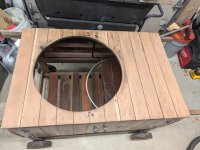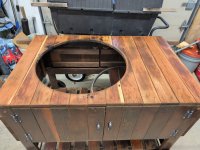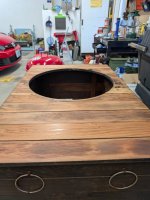Josh Dekubber
TVWBB Hall of Fame
I like it though I think it adds characterThe wood is redwood. The black around the nails is the tannins reacting with the steel nails. You/they should of used SS fasteners so you don't get that bleeding effect.
I like it though I think it adds characterThe wood is redwood. The black around the nails is the tannins reacting with the steel nails. You/they should of used SS fasteners so you don't get that bleeding effect.
I agree, I like the lookI like it though I think it adds character
I'm totally new to this type of woodwork, can you explain that a little more? Does it go on after sanding and before the urethane?Always good to put a coat of oil based sanding sealer on before finish coats to raise the grain for 220 sanding and seal the wood so your topcoat builds.
Yes based on what you’re doing, before the urethane. It’s going to seal the wood and raise the grain giving a rough feel that you would use 220 grit sandpaper and will be very smooth after sanding to tack off the dust. The sanding sealer is sealing the wood to keep your urethane from absorbing multiple coats before building a finish and the sealer gives a better looking more durable finish. If you were staining the wood you would apply the sealer immediately after the stain and before the urethane or varnish. I was a painter many years ago and most people don’t know about or use sanding sealer in the process but it makes a huge difference.I'm totally new to this type of woodwork, can you explain that a little more? Does it go on after sanding and before the urethane?



Cool stuff, there, Mike.Yes based on what you’re doing, before the urethane. It’s going to seal the wood and raise the grain giving a rough feel that you would use 220 grit sandpaper and will be very smooth after sanding to tack off the dust. The sanding sealer is sealing the wood to keep your urethane from absorbing multiple coats before building a finish and the sealer gives a better looking more durable finish. If you were staining the wood you would apply the sealer immediately after the stain and before the urethane or varnish. I was a painter many years ago and most people don’t know about or use sanding sealer in the process but it makes a huge difference.
Great idea!I also had the idea to swap the warped board to the end so that the end "wall" holds it straight. Success!
Hey Jon any of the paint stores will have it or the big Orange or big Gray/Blue. All painters use it. A must for clear topcoats. Most folks outside of professional painters are totally unfamiliar with it. Hope it helps.Cool stuff, there, Mike.I have never heard of that, but then again in my regular life I am just an accountant!!
Any links for brand names for the sanding sealer?
Not to be obstinate but sanding sealer requires one coat to raise grain and the grain will not raise again then sanding with 220, tack off dust with a rag dampened very slightly with lacquer thinner(not paint thinner) and apply your clear topcoats. The water method is how I raise the grain on my custom built cutting boards so it’s food safeHere is an additional step when looking for an exceptional varnish/lacquer finish. At 220 grit, take a sponge and wet the surface to raise the grain, a few hours later re sand with 320, lightly, this will give you a nicer end product. This is coming from instrument finishing techniques. It will make a subtle but, definite surface improvement. Five coats of varnish later it will have a greater depth visually. Light wet sanding between varnish (or poly) I wasn’t particularly good at the patience required but, I’ve known several excellent luthiers who used that method and have stunning results.
I’ll post some pictures on an old cutting board thread and avoid the scolding of a hijack since we were talking wood finishing. But we agreeMike, I wasn’t saying that sealer is bad, just a different finishing technique. In particular that it’s important with varnish not always nitrocellulose , the density of nitro is much more forgiving than old fashioned varnish.
Love to see some pix of your boards!
Totally agree, that instrument level finish on a grill table would be overkill, I might go a little nuts on the “blue rascal” gasser but then again, I may not. I have a neighbor that is a big epoxy guy so, I might chat him up a little about doing the slats for me…hmm…
Post away!I’ll post some pictures on an old cutting board thread and avoid the scolding of a hijack since we were talking wood finishing. But we agree
